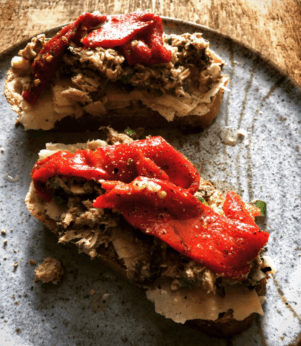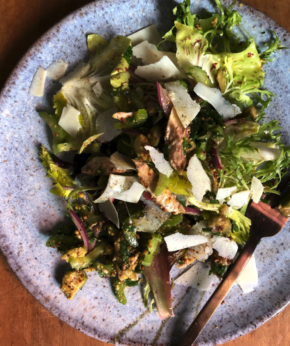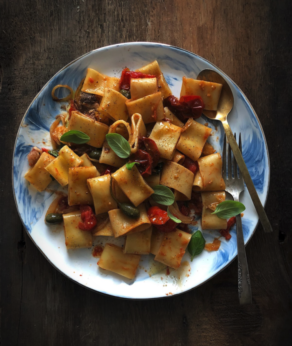Eating herring Is Caring.

When you’re choosing what kind of fish to eat for dinner, what do you consider? Is it farmed or wild? How sustainable is it? Where is it from? Is it organic? These questions can be difficult to answer. You may blindly buy the wild salmon because its vibrant vermilion color suggests that it must be healthy. Or perhaps you choose the halibut because the fishmonger says, “It just came in today!” Most Americans are after large, meaty fish with mild flavor. They don’t want to deal with fish butchery and fishy smells. Big sides of salmon, tuna steaks and halibut fillets are the fish stars of the culinary world. But, unfortunately, these options aren’t desirable when it comes to sustainability, cost or health.
Small species, such as anchovies, sardines, herring and mackerel, are some of the best choices to keep both your body and the ocean happy. Yet these fish barely don’t rank on the popularity scale. People often associate anchovies and other small fish with a pungent, fishy smell, and that’s true sometimes. But eating small fish doesn’t mean covering your pizza in anchovies. There are many ways to prepare small fish that will appeal to any palate. Here are five great reasons to introduce them to your diet, along with some recipes that are surprisingly easy and delicious.
1. They are cheap.
Tins of mackerel, sardines and herring usually sell for between two and three dollars for two servings. Buying fresh fish can be pretty expensive, and its shelf life is short. Keep tins of herring in your cupboard until you’re ready to slip into the oily goodness.
2. They are widely available.
You can find tins of small fish in any grocery store, most corner stores and sometimes even your local gas station. If you’re hungry for a snack, I wouldn’t recommend a can of oil-packed herring for the car, but there’s no reason not to stock up!
3. They are very healthy.
Anchovies and sardines are two of the richest sources of healthy omega-3 fatty acids, which can help fight heart disease and enhance brain function. Our bodies need these fatty acids but can’t produce them on their own. Small fish are also a great source of protein, calcium and vitamin D. They are rich in minerals and nutrients like iron, magnesium and zinc.
4. They are low in contaminants.
Herring, mackerel and sardines are great for eating because they have low mercury levels compared to predatory species like swordfish, shark and tuna. If you’re concerned about contaminants in your seafood, these are great options.
5. They are sustainable.
Small fish, such as sardines, herring and anchovies, are designed by nature to withstand heavy predation. They are like the rabbits and mice of the underwater world. This is not to say that there’s a limitless supply, but they have much more rapid growth than bigger predatory fish. Eating wild predatory fish, such as salmon and tuna, is unsustainable. Overfishing wild salmon has depleted the supply. To keep up with the demand of predatory fish like salmon, farming has become the viable option. Farming fish also comes with a whole slew of unsustainable issues. Farmed salmon need to be fed a ton of protein, which usually comes in the form of small, oily fish, such as herring and sardines. We could be going straight to the source by eating them ourselves. Farm-raised fish are also less nutritious than wild-caught fish and risk polluting our local waterways. They are more vulnerable to parasites and diseases and can risk the health of native species if pests overflow from farms into the wild.
Kippers on Toast with Roasted Red Peppers and Manchego
Servings: 2
This recipe comes together in a snap. It resembles the flavors of a Spanish tapa: Salty Manchego cheese, rich roasted red peppers and smoky kippers tower on a slice of sourdough. Sliced celery and slivered almonds add a satisfying crunch. This regal open-faced sandwich is far more elevated and flavorful than the humble tuna melt. Make mini-versions for a cocktail party or make it for a quiet lunch at home.
- 1 125 g can kippers packed in oil, drained
- 2 tbsp mayonnaise
- 3 tbsp blanched slivered almonds
- 2 tsp horseradish
- 3 tbsp sliced green onion
- 4 slices Manchego cheese
- 2 pieces good-quality sourdough toast
- 2 roasted red peppers, sliced
- salt and pepper
- In a bowl, mash kippers with mayonnaise, almonds and horseradish. Stir in green onion.
- Layer slices of cheese on toast. Divide kipper mixture between slices and then top with slices of roasted red peppers.
- Season with salt and pepper and serve with a little green salad.
Green Olive and Celery Salad with Flaked Mackerel
The dressing for this salad makes up most of the dish. Briny Castelvetrano olives, celery, shallot and tinned mackerel get tossed in olive oil and vinegar and then spooned over big leaves of lettuce. The mackerel is mild but adds a richness to the salad. It also packs in some serious protein. This salad makes a wonderful appetizer at a dinner party or a casual Saturday lunch.
- 1 cup pitted Castelvetrano olives, sliced
- 2 ribs celery, thinly sliced
- 1/4 cup finely chopped shallot
- 2 tbsp grainy mustard
- 1/2 cup olive oil
- 1/4 cup apple cider vinegar
- 120 g tinned mackerel packed in oil, with the oil
- 2 heads of any combination of Boston lettuce, red leaf lettuce, little gem lettuce, frisée lettuce.
- 1/2 cup shredded Ricotta Salata or Pecorino Romano cheese
- In a bowl, mix olives, celery, shallot, mustard, oil and vinegar. Sir until combined. Gently stir in mackerel. Season with a little salt and pepper. Let stand for 15 minutes.
- Arrange lettuce leaves on a platter. Spoon mackerel mixture over leaves and then drizzle remaining liquid over salad. Garnish with shredded cheese and serve immediately.
Sardines Puttanesca and Minty Pasta
Servings: 2
This dish is not a true puttanesca. It has much more mild flavors thanks to the absence of salty black olives and potent anchovies. Instead of adding anchovies, big hunks of canned sardines are stirred into the sauce. Fresh mint garnishes this dish and gives it a surprisingly fresh flavor profile.
- 5 tbsp extra-virgin olive oil
- 1 pint cherry tomatoes
- 2 to 3 cloves garlic, smashed
- 1 small onion, thinly sliced
- 200 g pasta of your choice
- 2 tbsp capers
- 120 g tinned sardines packed in oil, drained
- 1/4 cup fresh mint leaves
- Preheat your oven to 400F and bring a large pot of salted water to a boil.
- On a baking sheet lined with parchment paper, drizzle tomatoes and garlic with 2 tbsp olive oil, salt and pepper. Roast until tender and browned, about 15 minutes.
- Meanwhile, heat remaining olive oil in a large pan over medium. Add onion and cook until translucent and fragrant, about 5 minutes, stirring often.
- Cook pasta according to package directions. Drain, reserving about 1/2 cup pasta water.
- Add capers, roasted tomatoes and garlic to pan with onion and stir. Gently apply pressure to a few of the tomatoes so that they burst and add to the sauciness.
- Stir in pasta with a few tablespoons of pasta water. Season with salt and pepper.



The Sardines Puttanesca recipe has sardines in the ingredients but not in the instructions. Perhaps it’s a garnish with the mint leaves? 🙂
If you genuinely care you won’t eat any at all. All of the nutrients derived from fish, and from animals in general, can be obtained more healthfully, humanely, and environmentally responsibly from plant sources, including the many marvelous vegan versions there are of virtually every type of seafood (and other foods) imaginable: http://www.FishFeel.org/seafood